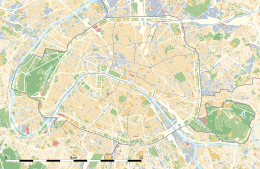Île aux Cygnes

Île aux Cygnes from the top of the Eiffel Tower. The Statue of Liberty replica is at the far end.
|
|
| Geography | |
|---|---|
| Location | Paris, France |
| Coordinates | 48°51′10.03″N 2°17′00.95″E / 48.8527861°N 2.2835972°ECoordinates: 48°51′10.03″N 2°17′00.95″E / 48.8527861°N 2.2835972°E |
| Area | 0.013 km2 (0.0050 sq mi) |
| Administration | |
|
France
|
|
Île aux Cygnes (French pronunciation: [il o siɲ]; English: Isle of the Swans) is a small artificial island on the river Seine in Paris, France, in the 15th arrondissement. It was created in 1827 to protect the port of Grenelle. It should not be confused with an earlier Île des Cygnes that was attached to the Champ de Mars in the late 18th century.
The uninhabited island is 850 metres (2,789 ft) long and 11 metres (36 ft) at its widest point, making it the third-largest island in Paris. A tree-lined walkway, named L'Allée des Cygnes (Path of Swans), runs the length of the island. Since 2012, there has been a public workout space with bicycles and a climbing wall underneath the Pont de Grenelle, close to a Statue of Liberty replica.
The island is crossed by three bridges: the Pont de Grenelle, the Pont Rouelle and the Pont de Bir-Hakeim. It is served by the Passy and Bir-Hakeim Métro stations.
A notable feature is a quarter scale replica of Liberty Enlightening the World, commonly known as the Statue of Liberty, 22 metres tall and facing west in the direction of its larger sibling in New York City. Inaugurated by President Marie François Sadi Carnot on 4 July 1889, nearly three years after its US counterpart, it was given to the city of Paris by the Parisian community in America to mark the centennial of the French Revolution.
...
Wikipedia

